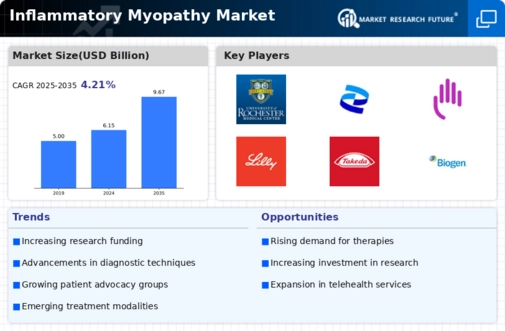Growing Awareness and Education
The Inflammatory Myopathy Market is benefiting from a surge in awareness and education regarding these rare diseases. Increased efforts by healthcare organizations and patient advocacy groups have led to improved understanding among both healthcare professionals and the general public. This heightened awareness is crucial, as it encourages early diagnosis and treatment, which can significantly enhance patient quality of life. Furthermore, educational initiatives are likely to drive research funding and innovation in treatment options. As awareness continues to grow, the Inflammatory Myopathy Market may see a corresponding rise in patient engagement and demand for specialized care.
Advancements in Diagnostic Techniques
The Inflammatory Myopathy Market is experiencing a notable transformation due to advancements in diagnostic techniques. Enhanced imaging modalities and biomarker identification have improved the accuracy of diagnosing inflammatory myopathies. For instance, the introduction of high-resolution MRI and muscle biopsy techniques has led to earlier detection and better patient outcomes. This is particularly relevant as the prevalence of inflammatory myopathies is estimated to be around 14 to 20 cases per 100,000 individuals, indicating a substantial patient population that requires effective management. As diagnostic capabilities continue to evolve, the Inflammatory Myopathy Market is likely to witness increased demand for targeted therapies and personalized treatment plans.
Emergence of Novel Therapeutic Agents
The Inflammatory Myopathy Market is poised for growth with the emergence of novel therapeutic agents. Recent clinical trials have shown promising results for new biologics and small molecules targeting specific pathways involved in inflammatory myopathies. For example, therapies that inhibit immune responses or modulate muscle inflammation are gaining traction. The market for these innovative treatments is projected to expand significantly, with estimates suggesting a compound annual growth rate of over 7% in the coming years. This influx of new therapies is likely to reshape the treatment landscape, offering patients more effective options and potentially improving outcomes in the Inflammatory Myopathy Market.
Rising Incidence of Autoimmune Disorders
The Inflammatory Myopathy Market is influenced by the rising incidence of autoimmune disorders, which includes inflammatory myopathies. As the prevalence of autoimmune diseases continues to increase, the demand for effective treatments and management strategies is also on the rise. Current estimates suggest that autoimmune disorders affect approximately 5-8% of the population, with inflammatory myopathies representing a subset of these conditions. This growing patient population is likely to drive market growth, as healthcare providers seek to address the needs of individuals suffering from these debilitating diseases. Consequently, the Inflammatory Myopathy Market may see an uptick in research initiatives and therapeutic developments aimed at this demographic.
Increased Investment in Research and Development
The Inflammatory Myopathy Market is witnessing increased investment in research and development, driven by the need for better understanding and treatment of these complex diseases. Pharmaceutical companies and research institutions are allocating substantial resources to explore the underlying mechanisms of inflammatory myopathies. This investment is crucial, as it not only fosters innovation but also enhances collaboration among stakeholders. The focus on R&D is expected to yield new insights and therapeutic strategies, thereby expanding the treatment options available to patients. As a result, the Inflammatory Myopathy Market is likely to experience a surge in new product launches and advancements in care.


















Leave a Comment